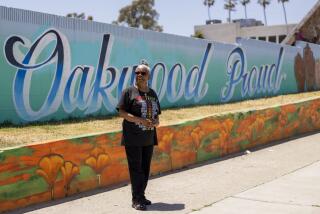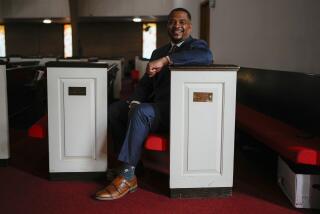Racial Protest Splits Urban Neighborhood : Philadelphia Black Couple Forced to Move; Interracial Pair Plans to Stay Despite Threats
- Share via
PHILADELPHIA — In the Elmwood neighborhood, one corner tavern displays over its bar the Southwest Shuffleboard League runner-up trophy and photos of Frank Sinatra and Elvis Presley. Before answering the telephone, the bartender asks a patron playing shuffleboard: “Fred, you here?”
Elmwood is a place where teen-agers play football in the street, where the kids go to the grocery for Big Foot red candy and Rocky IV bubble gum, where parents work at the Scott Paper Co. and the Franklin Mint. It is also a place where blacks are called “colored” and are decidedly not welcomed by many of the white residents.
A black couple, Marietta Bloxom, a 25-year-old department store supervisor, and Charles Williams, a 23-year-old worker at a fast-food hamburger chain, learned this the hard way when they moved to Elmwood from an apartment in a black neighborhood Oct. 31.
Unprepared for Hostility
So, too, did Gerald and Carol Fox, a black man and a white woman who moved in 2 1/2 weeks later and three blocks away.
Bloxom said she was unprepared for the hostility that greeted them: windows shattered by BBs, bottles tossed at the house, a demonstration by 400 whites outside the house Nov. 20.
At the Fox house, where 200 whites milled about and chanted the following night, vandals had by then already axed kitchen cabinets, destroyed a lamp, a clock radio and the water and oil heaters, and left behind a broken bottle stuffed with a rag soaked in gasoline. The night of the demonstration, reporters watched deli workers pass out free coffee to protesters.
Bloxom and Williams’ home was later gutted by fire from an arsonist, even they were packing to leave Elmwood. The Foxes, however, say they are staying.
The tension has eased somewhat as even the white neighbors reacted in horror to the arson attack, and both families have received letters and good-luck charms from people expressing sorrow and wishing them well. Carol Fox said she had received more than $600 in cash donations, a food basket, home-made candy, flowers and Christmas cards.
‘A Friendly Neighbor’
“I think those people who protested should be ashamed of themselves,” said one letter, signed only “a friendly neighbor.” “They are supposed to live in the ‘City of Brotherly Love.’ I saw people I used to respect, but I don’t no more. I saw people there that were not even from this neighborhood. I can’t believe this is happening in 1985. I just wanted you and your family to know it is not everyone doing this terrible thing.”
Philadelphia is a patchwork of neighborhoods, many of them with staunch racial or ethnic identities. A visitor could spend at least a month sampling the different foods and cultures. But the strong identities sometimes lead to isolation from the city as a whole.
“There is a housing pattern that exists in Philadelphia in which you will find many black people live in north and west Philadelphia and certain areas of Germantown and Mount Airy,” said Leah Gaskin White, executive director of the Philadelphia Commission on Human Relations.
“You’ll find, on the other hand, many white families live in south Philadelphia and the northeast and certain parts of Kensington,” said White, who is black. “But . . . we see in northeast Philadelphia, which has been traditionally a predominantly white area, black families moving into that area without protests.”
Understanding Limited
White said some people live their whole lives in one neighborhood.
“And that is their entire experience,” she said. “They are limited, therefore, in their ability to understand what the majority of people understand . . . that people of different races and other groups live together very well throughout the city without any difficulty.”
Elmwood, a tidy neighborhood of two-story brick row houses, some with Christmas wreaths on front doors, is the kind of parochial community that tends to be isolated, White said.
“It’s a neighborhood that people describe as a neighborhood of neglect,” she said. “It’s in the fringe part of the city so that, in recent years, there’s been a decline in industry and other business activity in the area. Members of the community feel neglected in terms of economic development and services.”
High Unemployment
Social problems--high unemployment, a large number of single-parent families and inadequate health services--exist for blacks and whites alike in southwest Philadelphia, said the Rev. William Yeats, who is white and chairman of Southwest Task Force Inc., an agency established five years ago to promote racial harmony. The southwest Philadelphia area, characterized by Yeats as a subcity of 80,000 people, is about 53% black.
“The economic status of the black and white communities is similar,” he said. “All of those conditions build a framework in which people feel anxious about what little treasure they have in this world and what they think they’re going to do to protect it.”
That is largely why whites felt threatened last month when the Williams-Bloxom couple and the Foxes bought their houses, each for about $20,000, from the Veterans Administration after the previous owners defaulted on GI loans.
When Williams and Bloxom moved in, Yeats said, some whites called the task force to report that real estate brokers were contacting them about selling their houses.
500 Attended
Yeats said the protests were spawned at what was to have been a small meeting of perhaps a dozen neighbors to decide what to do; 500 people showed up, and emotions took over.
“Allegedly, fliers were circulated,” Bobby Malone, acting executive director of the task force, said. “But we have not seen any physical evidence of any kind of solicitation materials being circulated of an inflammatory nature.”
White said the Commission on Human Relations had found no evidence of blockbusting, the practice of encouraging homeowners to sell their homes quickly, often at a loss, by suggesting that purchases by minority groups will bring values down.
“You know what happens when colored move in,” said an elderly man a few houses down who has lived on the block for 50 years. He pointed his thumbs toward the sidewalk.
Most whites insisted that they are not racists.
“The difficulty,” said White, “is that the persons do not want to see themselves as racists, since racism is not a term that seems to be popular in the 1980s. If this were the ‘60s, it would be called racist.”
More to Read
Sign up for Essential California
The most important California stories and recommendations in your inbox every morning.
You may occasionally receive promotional content from the Los Angeles Times.










